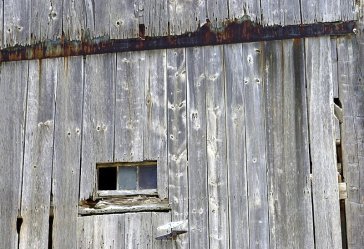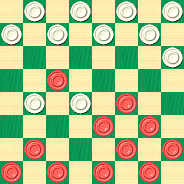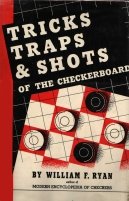A Bristol Broadside, Part 4

You've surely heard the expression, "Can't hit the broad side of a barn," and it's apt for the play on today's theme, as various erroneous moves cause the balance of the game to change often. It seems as if the players couldn't hit the broad side of the checkerboard, so to speak.
It all takes place in this, the fourth and final part of A Bristol Broadside, as found in Willie Ryan's incomparable study, Tricks Traps & Shots of the Checkerboard.
Here's the run-up to this variant.
| 1. | 11-16 | 24-20 |
| 2. | 16-19 | 23-16 |
| 3. | 12-19 | 22-18 |
| 4. | 10-14 | 18-15 |
| 5. | 7-10 | 20-16 |

BLACK
Black to Play
B:W32,31,30,29,28,27,26,25,21,16,15:B19,14,10,9,8,6,5,4,3,2,1.
From this point, Willie looks at the move 9-13. But we're going to present things a little differently today. Here's the actual play for the next couple of moves:
| 6. | 9-13 | 16-12 |
| 7. | 5-9 | 27-23 |
From here, Black should win. But the challenge for you, our reader, is not just to find the Black win, but to critique the line of play given just above, starting with 9-13.
Willie had his own ideas, and they were mostly right. The KingsRow computer engine, as usual, has its ideas, and they diverge from Willie's at various points.
What are your ideas? Can you hit the broad side of the checkerboard? Take your time here; this is most definitely not an easy setting. When you've completed your analysis, click on Read More to see some detailed analysis.![]()
Solution and Notes
Lettered notes are by Willie Ryan. Numbered notes are by the Editor, using the KingsRow computer engine. The analysis is quite detailed, but well worth your time to play through.

BLACK
Black to Play
B:W32,31,30,29,28,27,26,25,21,16,15:B19,14,10,9,8,6,5,4,3,2,1.

Variation 3
| 9-13---A,1 | 32-27 | 1-5 | 25-9 | 18-23 | 12-3 |
| 16-12---B,2 | 8-11 | 22-17---6 | 5-14---7 | 22-17 | 26-30 |
| 5-9---C,3 | 27-23---5 | 13-22 | 29-25 | 15-18---10 | 3-10 |
| 27-23---D,4 | 11-20 | 26-17 | 14-18---E,8 | 17-13---G,11 | 30-7---I,13, |
| 2-7 | 23-16 | 9-13 | 31-26 | 23-26 | Ginsberg |
| 23-16 | 6-10 | 30-25 | 10-15---9 | 21-17---H,12 | won. |
| 10-19 | 25-22 | 13-22 | 26-22 | 3-8 |
A---For all practical purposes, this move is a dead loss---1, and it has led many champions to defeat. It was tried by Louis C. Ginsberg against Basil Case in the semifinals of the seventh American Championship tourney. At the time, Ginsberg needed a win to remain in the tournament, as he was a life and a half down, this being the last game of a deadlocked heat. Hence, Ginsberg aimed for a victory by taking 9-13, since a draw would avail him nothing.
B---This is indeed a remarkable game. Ginsberg, needing a win, made a very doubtful move at A, in a last-ditch drive for a win. Mr. Case, on the other hand, needed only a draw to advance into the championship finals with Asa Long. Case's 16-12 move, however, at once changed the whole complexion of the situation, for it is so weak I would not venture to show a draw after it. The real surprise element in this game is the revelation that from this point on, both players at various times "scientifically" eliminated each other by their blunders, with neither player taking advantage of the errors made by the other. Had Mr. Case played 25-22 at B, the very best Ginsberg could have hoped for was a draw. After 25-22, if black had replied 8-12 or 5-9, then 27-23 would have been strong; and if the play had gone 8-11, 15-8, 4-20, then 27-23 would have been powerful.
C---A powerful waiting move that at once puts a deadly dent in the white defense.
D---After this, white must lose, although black's position is so strong that he can put white in jeopardy no matter what move is taken. 25-22 and 27-24 are better defenses, but there can be no draw after 16-12---B.
E---With this move, Ginsberg theoretically eliminated himself from the tournament as it allows the draws mentioned in Notes G and H. Asa Long, who annotated the game in the tournament book, should have pointed out that black missed a snappy forced win here, by: 10-15*, 31-26---F, 15-19, 26-22, 4-8, 22-17, 14-18, 17-14, 20-24, 14-9, 8-11. Wm. F. Ryan.
F---If 25-22 is played, then follow up with: 15-19*, 31-26; at this point, 4-8 or 20-24 will win. If 28-24 is played, then white will win with: 20-27, 31-24, 15-18, 24-19, 18-23, 25-22, 23-27, 22-17, 14-18, 17-14, 27-32, 14-9, 32-27, 9-6, 27-24, 19-15, 7-11. Wm. F. Ryan.
G---Mr. Long inserts a casual note at this juncture to observe that the text move "was what the wily Ginsberg wanted." If such was the case, it was a phantom Mr. Ginsberg was pursuing! He missed the live one at Note E! Apparently, Mr. Long was under the impression that 17-13 was Case's losing move, as he quotes a draw on 17-14, 23-26, 21-17, etc., by E. E. Cresswell. The Cresswell draw, though sound, is of no scientific importance, as Ginsberg missed a win at E, which Long and Cresswell failed to point out.
H---Mr. Ginsberg must be a hypnotist. Case stumbled into the trap as though mesmerized. Although Mr. Long's comments on this game conclude at G, it is extremely doubtful that Mr. Ginsberg really had a win here. Although the ending is admittedly critical for white, the following appears susceptible to a draw: 13-9*, 26-30, 9-6, 4-8, 6-2, 8-11, 2-6, 30-26, 6-9, 26-23, 9-14*, 11-15, 14-9*, 15-19, 9-6*, 18-22, 25-18, 23-14, 6-2, 7-10, 16-11*.
I---By losing this game, Mr. Case was eliminated from the tournament, Ginsberg advancing into the finals with Long. The pendulum of fate swung back and forth several times during the play. At A9 Ginsberg started the panic with the losing 9-13 gambit; then Case missed the bus at B and found himself in difficulties. With the win well in hand at E, Ginsberg failed to clinch it and permitted Case to escape at G and H. Finally, Case must have decided that his cause was hopeless, and at H he gave up.
1---14-18 is indeed correct, but saying 9-13 is a dead loss perhaps pushes things a little, though White definitely gets a significant advantage.
2---27-23 would be even better here than Willie's suggested 25-22. Willie doesn't think the game can be drawn at this point, but KingsRow disagrees.
3---After this error, computer evaluates the game at just about dead even.
4---The computer agrees with Willie and evaluates a probable win for Black.
5---27-24 is KingsRow's choice here.
6---Definitely not as good as 29-25.
7---The game evaluates as a sure loss at this point.
8---While inferior (see Willie's note) this move should still win, and not allow a draw as Willie states.
9---4-8 is stronger; Ginsburg seems intent on giving back his lead!
10---23-26 kept the win. The game is now a draw.
11---Definitely loses. 17-14 would secure a draw according to computer analysis, which contradicts Willie's claim that Black should still win after 17-13.
12---13-9 would have held out longer, though still a probable loss, as Willie demonstrates. After the text move, it's hopeless.
13---Black wins!
You can email the Webmaster with comments on this article.